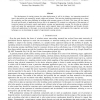Free Online Productivity Tools
i2Speak
i2Symbol
i2OCR
iTex2Img
iWeb2Print
iWeb2Shot
i2Type
iPdf2Split
iPdf2Merge
i2Bopomofo
i2Arabic
i2Style
i2Image
i2PDF
iLatex2Rtf
Sci2ools
WMCSA
2008
IEEE
2008
IEEE
Urban sensing systems: opportunistic or participatory?
The development of sensing systems for urban deployments is still in its infancy. An interesting unresolved issue is the precise role assumed by people within such systems. This issue has significant implications as to where the complexity and the main challenges in building urban sensing systems will reside. This issue will also impact the scale and diversity of applications that are able to be supported. We contrast two end-points of the spectrum of conscious human involvement, namely participatory sensing, and opportunistic sensing. We develop an evaluation model and argue that opportunistic sensing more easily supports larger scale applications and broader diversity within such applications. In this paper, we provide preliminary analysis which supports this conjecture, and outline techniques we are developing in support of opportunistic sensing systems.
| Added | 01 Jun 2010 |
| Updated | 01 Jun 2010 |
| Type | Conference |
| Year | 2008 |
| Where | WMCSA |
| Authors | Nicholas D. Lane, Shane B. Eisenman, Mirco Musolesi, Emiliano Miluzzo, Andrew T. Campbell |
Comments (0)

